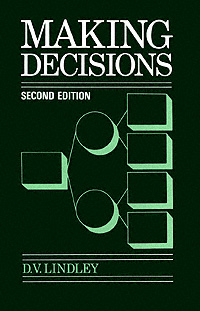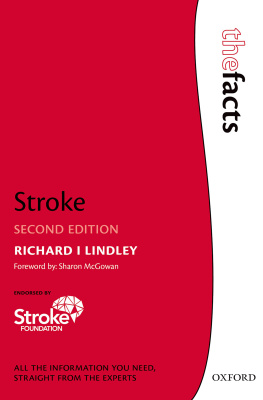publisher
:
John Wiley & Sons, Ltd. (UK)
print isbn13
:
9780471908081
ebook isbn13
:
9780585334233
subject
Statistical decision.
subject
:
Statistical decision.
Page iii
Making Decisions
Second Edition
D. V. Lindley
Formerly Professor of Statistics
University College London
Page iv
Copyright 1971, 1985 by John Wiley & Sons Ltd,
Reprinted February 1990, March 1991, April 1992, April 1994, September 1998
All rights reserved.
No part of this book may be reproduced by any means, or transmitted, or translated into a machine language without the written permission of the publisher.
Library of Congress Cataloging in Publication Data:
Lindley, D. V. (Dennis Victor), 1923
Making decisions.
Includes index.
1. Statistical decision. I. Title.
QA279.4.L56 1985 519.5'42 85-12010
ISBN 0 471 90803 7 (cloth)
ISBN 0 471 90808 8 (paper)
British Library Cataloguing in Publication Data
Lindley, D. V.
Making decisions.2nd ed.
1. Probabilities 2. Decision-making
I. Title
519.2 QA273
ISBN 0 471 90803 7 (Cloth)
ISBN 0 471 90808 8 (Paper)
Printed and bound in Great Britain by Biddles Ltd, Guildford and King's Lynn
Page vii
Preface
to the First Edition
This book is about decision-making: about the logical processes that need to be used in arriving at a decision. It is not much concerned with the ways in which people currently make decisions. There is no material on delegating responsibility, on how the paper-work should be organized, or on the personality of the decision-maker. Instead we discuss the subject from a scientific viewpoint and see what basic principles there are in any choice of an action. We study the rules of decision-making. The book is addressed to business executives, soldiers, politicians, as well as scientists; to anyone who is interested in decision-making and is prepared to take the trouble to follow a reasoned argument. In particular, it is addressed to university students in any discipline.
The main conclusion is that there is essentially only one way to reach a decision sensibly. First, the uncertainties present in the situation must be quantified in terms of values called probabilities. Second, the various consequences of the courses of action must be similarly described in terms of utilities. Third, that decision must be taken which is expectedon the basis of the calculated probabilitiesto give the greatest utility. The force of 'must', used in three places there, is simply that any deviation from the precepts is liable to lead the decision-maker into procedures which are demonstrably absurdor as we shall say, incoherent.
The organization of the book is as follows. The first five chapters are devoted to a demonstration of the result stated in the last paragraph, together with extensive discussions of the twin concepts of probability and utility. It is here that the logical argument is tightest. It is included because no other discussion of the result can be so convincing as a demonstration of its inevitability. Chapter 6 studies how information can be used in decision-making and the next chapter discusses the value of the information. Decision trees, an important technical device for solving decision problems, are studied in Chapter 8, and a final chapter is a discussion of the conclusions reached in the study. There are several, mostly simple, exercises to which answers are provided.
In studying the logic of decision-making it is necessary to include a little mathematics. Every effort has been made to keep this to an absolute
Page viii
minimum. Most of the mathematical arguments that you will see on flipping over the pages can be avoided if necessary. There is, however, quite a lot of mathematical notation. This is essential for both brevity and clarity. Mathematical notation is only an addition to written language. Thus, if we wish to refer to the probability of striking oil at a particular spot after having had a favourable seismic test there, we could equally refer to p(A|B) where p( ) means 'the probability of', A means 'striking oil at a particular spot', the vertical line | means 'after having had' and B means 'a favourable seismic test there'. p(A|B) is simply shorthand for the English phrase. The notation not only has the advantage of brevity but also makes it easier to understand the principles involved. We can concentrate on p( ) and A, say, without being confused with oil and seismic tests. We can see the wood without the trees.
There are many examples in the book. All are rather simple and perhaps trivial. But we cannot begin a study of flight by building a Concorde or a 747. Until the easy is properly understood, the difficult must remain out of our reach. What is reasonably certain is that the difficult will not involve any new principles. The technology of implementing the principles is yet to come. Appreciation, not execution, is our immediate aim.
It should be emphasized that none of the material in this book is new. I have not thought it right in a work of this character to cite the original sources. Many writers have been responsible for the notions developed here: principally F. P. Ramsey, B. de Finetti, J. von Neumann, L. J. Savage and most recently J. Pratt, H. Raiffa, and R. Schlaifer, in whose company I spent a most rewarding period at the Harvard Business School.
The stimulus for writing this book came from Leigh Edmondson who, by continually asking me to lecture on the ideas, encouraged me to think about the basic principles in an elementary way. A first draft was read by P. H. Jackson, M. R. Novick, N. Forward, K. C. Bowen, and D. G. Smith. I am most grateful to them for commenting on the material in such a helpful and constructive manner. But, above all, I must thank I. Wilson who read the draft with meticulous care. If the book has any grammatical virtues at all, it is due to him. Finally, it is a pleasure to thank the secretaries, N. Pateman, P. Rhodes, and M. Ware who typed, retyped, and calculated with such care, and my family who encouraged me at all times.
The quotations at the beginnings of the chapters are taken from the Forsyte Chronicles by John Galsworthy, with the permission of William Heinemann Ltd. I am also grateful to the Editor of the













